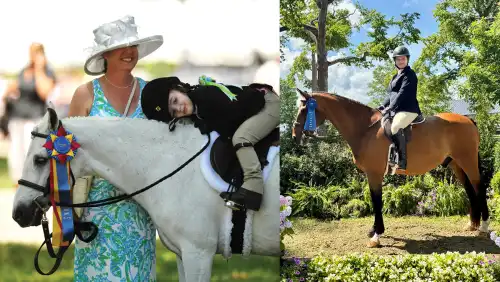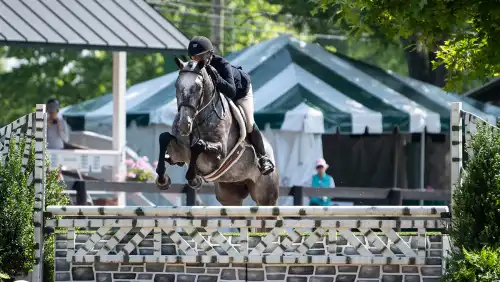On the final day of the George Morris Horsemastership Training Session, Jan. 4, riders got to put to use the concepts they’d been working on all week over a course of fences. Although they weren’t huge, most about 3’6”-3’9”, the basics—impulsion, rhythm and position—were paramount.
“I go back to impulsion over and over and over again because it’s the basis of riding,” said Morris. “It’s just like that golf cart or my car. I can’t do much with it until I turn it on. I can’t go forward, I can’t turn, I can’t do much on a horse if he’s not thinking forward. The mental traits are that he’s thinking forward. The physical traits, his paces are energetic, they’re vigorous, they’re active.”
A shortened warm up consisted of simple reminders on position. Morris pointed out to Michael Hughes that he needed to make sure that there was a straight line from his elbow to the bit and that his elbow was soft and following.
“The straight line we’re all taught about, we don’t adhere to it all that often,” he said. “A straight line is very important for the rest of your body because if one part of your body is off, it will affect the other part of your body.”
“If you drop your hands, what does that do to your back?” he asked. “It pulls your shoulder down and gives you what is called a too-soft or roached back.”
Quick exercises for self-carriage included some more shoulder-in and lengthening and shortening of the canter.
Morris was adamant that riders have a program for warming up, starting simple in an active walk or posting trot to respect the horse’s mouth and back, then moving on to more complex movements like shoulder-in and haunches-in with frequent changes of direction.
“This heavy, backward, heavy-seated, galloping riding offends me,” he said. “That’s how horses get sores backs. This country worshipped the forward seat for a very good reason. We had blood horses, Thoroughbred horses. They would not tolerate that heavy riding.”
“I want the horse to carry me,” said Morris. “I want less hand, less leg, less seat. Self-carriage is less. It’s fashionable today to go the other direction and carry the horse. That’s horse dealer’s advice. They have to do it that way because they have green horses, leg hangers, or bad horses.”
ADVERTISEMENT
Courses In Pieces
As riders began jumping, Morris had them all jump out of hand with an automatic release, an exercise repeated from the second day’s gymnastics.
“Watch her hand in the air,” said Morris as Lillie Keenan jumped Balance through the triple combination. “She keeps light contact and her hands alongside the neck and her following arm. The horse takes your hand, you don’t throw it, you don’t shove it, you don’t drop it. You follow the horse’s mouth. What the horse takes is what you give.”
He had the second group start over a cross-rail with a liverpool under it, similar to day three’s exercise, to make sure the horses were in front of the leg. A few horses were caught off guard and stopped, so Morris had them use their whips behind the saddle, even if they got to the jump too short.
“Distances are not always perfect,” he said. “I don’t care what distance you get to. Your intention is jump.”
Next, he moved on to pieces of a course that was set by designer Steve Stephens. He had riders jump an oxer, three strides to a skinny, as well as a right-handed bending line of an oxer, seven strides to the open water, then four strides to an oxer.
He wanted horses “loose to the base,” so they could learn self-efficiency and self-preservation, a theme that was repeated often throughout the week.
Morris dissected the tight right turn to the oxer and skinny line, standing at the point where he wanted to see a change made.
“This first half of the turn is your homework,” he explained. “That’s your half halt, that’s your rebalancing, that’s your flying change. At this point in the turn, it’s too late for homework. If you have a cross-canter, forget it. If your horse is rushing, forget it. This point of the turn is two things—line and distance. To get that distance here at this point of the turn, you follow the horse. That is ‘relax.’ That’s very difficult for people jumping a horse. Relax, let go, ease off, have some word that helps you hear, ‘Let go of your horse.’ Then you will measure the horse infinitely better.”
ADVERTISEMENT
When several horses struggled to get five strides to an in-and-out, Morris encouraged riders to cut their turns slightly in the corner and angle the first oxer to make the five strides come easier.
By the end of each session, riders put the whole course together, but still repeated lines if they had an issue.
Erin Fry’s borrowed horse, Caprice, stopped several times at the A element of the triple combination. Morris made sure she used her whip behind the saddle over each element, and by the end of the session, he jumped through confidently.
“When a horse gets tentative, you get positive. Over-positive,” he said. “Horses have great mental telepathy. There was a slight question in her rein as that horse was leaving the ground and he felt that. You have to have an attitude with the technique of conviction.”
The final exercise was a tall vertical that Morris wanted riders to get deep to.
“Follow your horse, wait for your horse,” he said. “That is very difficult to learn. That gets the bascule. That gets the holy grail of jumping called ‘round.’ That touch, correctly done, gets the bascule. That’s an exercise I used to finish a horse before going into the ring. Not slow, not chasing or under the pace. Pace to the base, deep, then get out of your horse’s way.”
After five days of intensive instruction, Morris was pleased with the outcome. The participants received a thorough education in his style of classical riding with an emphasis on dressage to improve the jumper.
“Great groups,” he said. “These kids as pilots are experts. Their goal is to become horsemen. That’s our goal with these people as professionals, whether they stay amateurs, but think professionally, or they actually become professionals, that’s the ideal. This type of week encourages professional mentality, the whole spectrum of the horse. You don’t see better kids than this.”
Watch the 2014 George H. Morris Horsemastership Training Sessions online for free at USEFNetwork.com. Find the complete schedule here.
See stories and photos from all sessions of the George H. Morris Horsemastership Training Session.














